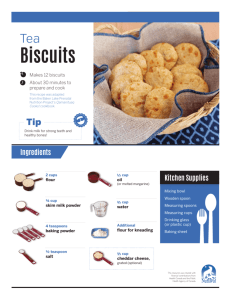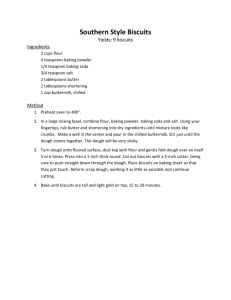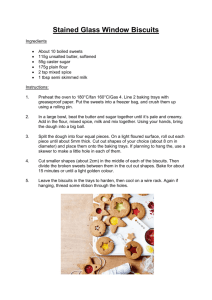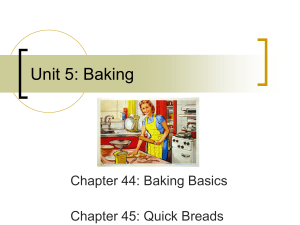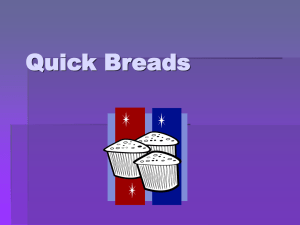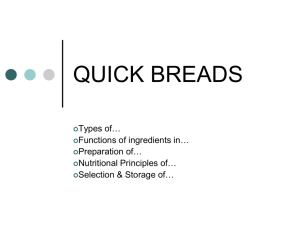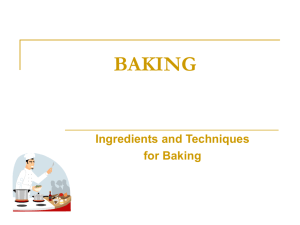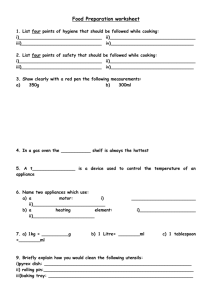Baking
advertisement
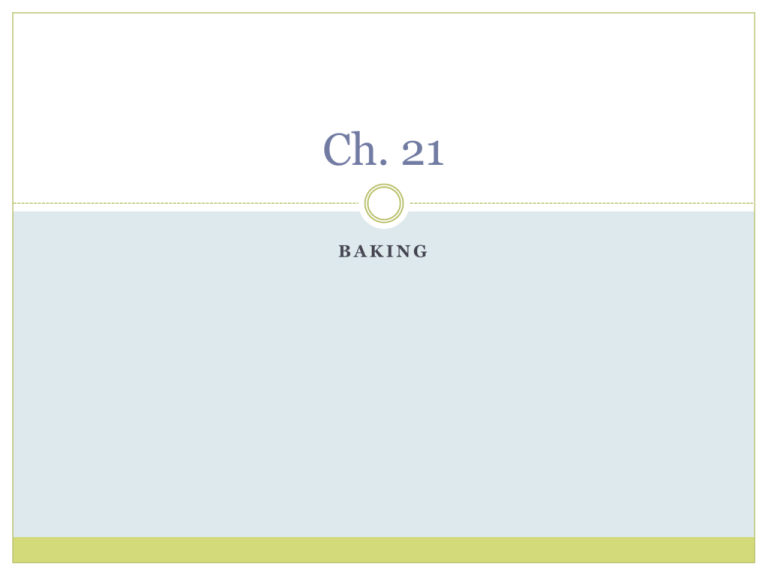
Ch. 21 BAKING Ingredients and Techniques for Baking SECTION 21.1 Ingredient Basics Flour Gluten – a protein that affects the texture of baked products Helps determine how much a product will rise All purpose – most popular, gives good results for most products Bread Flour – highest gluten content, gives bread a strong structure Cake Flour – contains less gluten, gives cakes a tender structure Whole-Grain Flour Weaker gluten than all-purpose Some have no gluten at all Products rise less and have a heavy texture Generally combines with all-purpose flour in recipes Cannot be sifted, must be stirred Contain some fat and should be stored in the refrigerator Liquid Water and milk are most common liquids Milk adds flavor and nutrients Helps baked goods brown better To reduce fat in a recipe use fat free milk Buttermilk is used in some recipes Gives slightly tangy flavor Adds acidity and affects leavening agent Leavening Agents A substance that triggers a chemical reaction causing a baked product to rise Make baked products less compact and gives softer texture Examples Air Steam Yeast Baking soda Baking powder Air Trapped in the mixture as it is beaten Creaming fat and sugar, sifting flour, beating egg whites When mixture is heated, the air expands and the product rises Example Angel Food Cake Steam Leavens products that contain high amounts of water When the mixture is heated, it turns to steam, which expands and causes the baked product to rise Example Popovers Cream puffs Yeast A microorganism that produces carbon dioxide gas as it grows Needs food (flour or sugar), liquid, and a warm temperature to grow Types Active Dry & Quick-Rising – come as dry granules in a packet, can be stored at room temperature Compressed – comes in individually wrapped cakes and must be refrigerated Baking Soda Sodium Bicarbonate Used whenever a recipe calls for buttermilk, yogurt, sour milk, or other acidic liquids When combined with this type of liquid, baking soda produces carbon dioxide gas Baking Powder Contains baking soda and a powdered acid The most common type is double-acting baking powder Releases some carbon dioxide when it is first mixed with a liquid, the remainder is released when heated Fat Fat adds richness, flavor, and tenderness to baked products Fats can be solid or liquid Solid and liquid fats cannot be easily substituted for one another Butter/shortening substitutes – regular margarine Do not use soft, whipped, or liquid margarine Solid shortening can be substituted for butter/margarine Any cooking oil can be used in baking as long as it has a mild flavor Fat Fats usually cannot be eliminated from baked products They can be reduced or partially substituted with applesauce or pureed dried fruits Store lard, butter, and margarine in the refrigerator Store shortening and oils at room temperature unless other directed Eggs Add flavor, nutrients, richness, and color They form structure in baked products When beaten, eggs add air to the mixture To reduce fat and cholesterol, use two egg whites in place of one egg Sweeteners Sugar is the most common sweetener Makes baked products tender, adds sweetness, flavor, and helps the crust brown Common sweeteners: white, brown, honey, corn syrup, molasses, and powdered sugar Some sugar substitutes are suitable for baking others are not Store sweeteners tightly covered in a cool place Flavorings Fruits, vegetables, and nuts add flavor, texture, and nutrients to baked goods Herbs, spices, and extracts are used in small amounts to add flavor Extracts are flavorings in liquid form Almond and vanilla are most common Store flavorings in tightly closed containers in a cool, dry place The Role of Gluten When flour and liquids are mixed together, gluten in the flour develops Becomes strong and elastic It forms a network of tiny air cells Air, steam, or gas produced by leavening agents is trapped by these cells When heated, the trapped gases expand and the product rises. Gluten in Action The Role of Gluten The longer the mixing time, the more gluten is developed Quick breads and cakes are mixed until just combined Yeast breads are mixed for a long time Batters & Doughs The ratio of liquid to flour determines whether a mixture is a batter or a dough Pour batter – thin enough to pour in a steady stream (pancakes, waffles, cakes) Drop batter – thick and usually spooned into pans (muffins, biscuits, cookies) Batters & Doughs Soft dough – soft and sticky but can be touched and handled (rolled biscuits, yeast breads, rolls) Stiff dough – firm to the touch, easy to work with and cut (pie crust, sugar cookies) Methods of Mixing Kneading – to work dough with your hands to thoroughly mix ingredients and develop gluten 1. 2. 3. 4. Turn the dough out on a very lightly floured surface With the heel of your hands, push down on the edge of the dough nearest you Fold the dough in half toward you can give a quarter turn Continue pushing, folding, and turning for the time directed in the recipe Kneading Preparing to Bake Baking pans affect the results of baking Size, shape, and material Most recipes are designed for light-colored metal pans If using glass lower temperature by 25°F Glass retains more heat and may produce darker crusts Dark pans produce thick crusts, lower oven temperature by 10°F Pan Preparation Grease and Flour – use waxed paper or a paper towel to spread fat inside of pan sprinkle a little flour into the pan tilt the pan at different angles until flour is spread evenly turn pan upside down over sink tap gently to remove excess flour Pan Preparation Spray with a vegetable-oil cooking spray Does not work with all baked products Follow directions on can Line a pan with paper Cut a piece of cooking parchment the same size and shape as the bottom of the pan Grease pan and line bottom with paper Conventional & Microwave Baking Conventional oven – uses dry heat Products brown and develop crispy crusts Unless otherwise stated, always preheat your oven, adjusting oven racks beforehand Microwave oven – uses moist heat Products do not brown or develop crust Products are very tender and moist Removing Baked Products from Pan Some products must be removed from the pan immediately after baking Others may cool for a few minutes in pan Others may need to cool completely in the pan Use cooling racks so baked goods cool faster and stay crisp Storing Baked Goods Baked products containing cream fillings and frostings should be refrigerated Store all other baked products at room temperature, covered tightly For long term storage, freeze in airtight containers Quick Bread SECTION 21.2 Quick Breads Breads that are quick and easy to make They do not require kneading Most use baking powder as a leavening agent Examples: Muffins Biscuits Pancakes Corn bread Fruit breads Muffins Muffins are prepared using the muffin method Muffins that are properly mixed will have a rounded, pebbly top with coarse but tender texture Over-mixed muffins will have peaks on top and are tough and heavy with long narrow tunnels Muffin Method 1. Sift together or mix all dry ingredients in a large bowl, using the back of a wooden spoon make a well in the dry ingredients 2. Beat all liquid ingredients together in a small bowl until they are well blended 3. Pour the liquid ingredients into the well you have made in the dry ingredients. Mix just enough to moisten the dry ingredients – batter should be lumpy 4. Fold in remaining ingredients (ex. Nuts, raisins, chocolate chips) Preparing and Baking Muffins Instead of greasing the muffin pan you can line them with paper baking cups Fill 2/3 full Muffins are done when nicely browned and a toothpick comes out clean Variations – fresh and dried fruit, vegetables, bran, and dairy products Loaf Breads Many loaf breads use the muffin method for mixing Most are baked in a greased loaf pan If the bread contains dried fruits or nuts, line the bottom of the pan with parchment paper Bread is done when nicely browned and toothpick comes out clean It is typical for quick bread loaves to crack on top Biscuits Delicate, small breads Two types drop or rolled Properly mixed biscuits have an even shape with a smooth, level top and straight sides Crust is an even brown When broken open the crumb is white Moist and fluffy, peels into layers Over mixed – low volume and rounded top (smooth) Pastry & Biscuit Method Cut in – to mix solid fat and flour using a pastry blender or two knives and a cutting motion 1. Sift together or mix dry ingredients in a large bowl 2. Cut the shortening into the flour until the particles are the size of peas 3. Make a well in the center of the dry ingredients, add the liquids, stir until the ingredients are blended and form a soft dough Rolled Biscuits Turn the dough out onto a lightly floured surface, knead about ten strokes Roll the dough out to a uniform thickness (1/2 inch) Cut biscuits using a biscuit cutter that is lightly dusted in flour Press straight down, DO NOT twist the cutter Re-roll leftover dough and make more biscuits Place biscuits on ungreased baking sheet Drop Biscuits Made by dropping dough from a spoon Contain more liquid than rolled biscuits The dough is too sticky to roll Drop the dough in mounds on a greased cookie sheet Can also be spooned or dropped on top of casseroles

